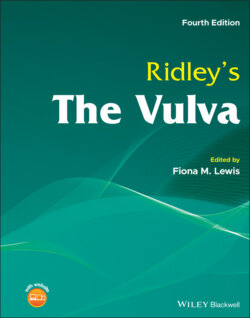Читать книгу Ridley's The Vulva - Группа авторов - Страница 24
Carnegie stages 13 and 14
ОглавлениеThe urogenital septum reaches the cloacal membrane at 30–32 days and fuses with the cloacal membrane, dividing the embryonic hindgut into the ventral (anterior) urogenital sinus and dorsal (posterior) rectum.
The cloacal membrane is also divided, the ventral part forming the urogenital membrane and the dorsal part forming the anal membrane. It eventually ruptures to form the urogenital and anal orifices. The genital folds develop from the anterior part of the cloacal folds, and the anal folds form the posterior component. (Figure 1.8c). The two primitive gonadal streaks proliferate to form a genital tubercle at the ventral tip of the cloacal membrane. These two genital tubercles grow further and must reach a critical mass, or only rudimentary structures will be formed. They then fuse to form the glans of the clitoris. Labioscrotal swellings and urogenital folds develop on each side of the cloacal membrane. As the urogenital septum reaches the cloacal membrane, the labioscrotal folds fuse posteriorly forming the perineal body, which separates the urogenital membrane from the anal membrane, but sexual differentiation at this stage is still indeterminate. Cells from cephalic mesonephric vesicles invade the coelomic epithelium on the medial aspect of the adjacent intermediate mesoderm to induce the formation of the indifferent gonad at 30–32 days [10].
